|
 Russula macrocystidiata Russula macrocystidiata
BiostatusPresent in region - Indigenous. Endemic
Images (click to enlarge)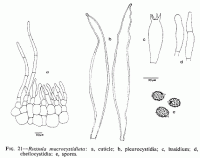 | 
Caption: C-3924
Owner: Herb. PDD | 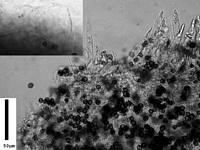
Caption: top left hairs on cap. Lower cheilocystidia and spores.
Owner: J.A. Cooper | 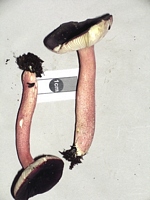
Owner: J.A. Cooper | 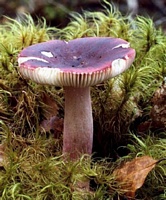
Owner: P. Leonard | 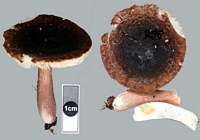
Owner: J.A. Cooper | 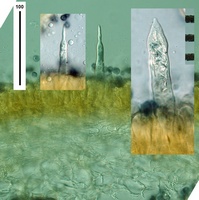
Caption: section through gill with pleurocystidia (inset enlarged). Melzers
Owner: J.A. Cooper | 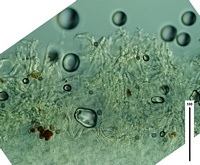
Caption: section through cap surface
Owner: J.A. Cooper | 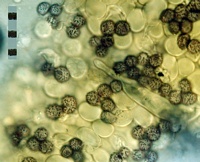
Owner: J.A. Cooper | 
Owner: J.A. Cooper | 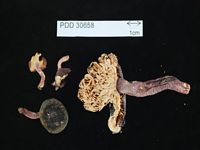
Caption: Dried type specimen
Owner: Herb PDD | 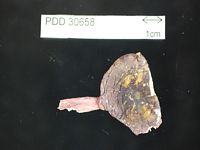
Caption: Dried type specimen
Owner: Herb PDD | |
Article: McNabb, R.F.R. (1973). Russulaceae of New Zealand. 2. Russula Pers. ex S.F. Gray. New Zealand Journal of Botany 11(4): 673-730 (http://www.rsnz.org/publish/abstracts.php).
Description: pileus: 2.5-7 cm diam., convex when young, centrally
depressed at maturity, slightly viscid under wet conditions, otherwise dry,
finely subpruinose under lens, velar remnants absent, greyish magenta, greyish
violet, or dull violet, often with yellow or greenish yellow areas; margins
entire, non-pectinate. Cuticle composed of erect, thin-walled or slightly thick-walled,
smooth, septate, hair-like hyphae to 125 µm long, 2.5-4.5 µm diam., without
staining contents in KOH, terminal cells unspecialised, tapering apically, originating
from inflated, short-celled hyphae arising from a layer of sphaerocysts, becoming
disorganised and partially gelatinised with age; pilocystidia absent. lamellae:
adnexed to adnate, crowded, thin, simple or forked near stipe, to
7 mm deep, white to creamy white, not discoloured at maturity but edges occasionally
tinted with colours of stipe, lamellulae rare or absent. stipe: 2-5.5 cm
long, ± equal or slightly expanded basally, 0.6-1.5 cm diam., dry, solid, finely
furfuraceous under lens, paler than pileus, greyish magenta, beetroot, or rose,
often with white flesh showing through, flesh white, unchanging on exposure
to air. Cuticle composed of interwoven, repent, thin-walled, septate hyphae
2.5-4.5 µm diam., terminal cells projecting and aggregated into clumps; caulocystidia
absent. spores: spore print not obtained; spores broadly
elliptical to ovate, obliquely apiculate, apiculus to -1.5 µm long, 9-11 X 7.5-9.5
µm, ornamentation dense, of amyloid or partially inamyloid, truncated spines
to 1.4-(1.8) µm high, in small confluent groups, joined basally by moderately
fine amyloid ridges and forming a partial reticulum, or occasionally isolated;
plage conspicuous. hymenium: basidia hyaline, clavate, 30-45 X 10.5-13
µm, 4-spored, sterigmata to 7 µm long; pleurocystidia scattered, numerous, fusiform
to broadly fusiform, hyaline, thick-walled, walls to 2.5 µm thick at mid point,
thinner at base and apex, contents refractive in KOH, projecting to 70 µm beyond
basidia, apices, acuminate, strangulate, or capitulate, 60-135 X 9-21 µm, cheilocystidia
numerous, filamentous, septate, simple or occasionally sparingly branched apically,
to 5 µm diam., intermixed with a few short pleurocystidia. hymenophoral
trama: heteromerous, intermixed. context of pileus: white, unchanging; structure heteromerous,
clamp connections absent. taste: Lamellae and gills mild. chemical characters: formalin n.r.; phenol—slowly faintly
deep purplish red; FeSO4—faint salmon pink; guaiacol—n.r.; KOH on pileus —bright
brownish orange; on context—n.r.; NH4OH on pileus and context—n.r.
Habitat: Solitary or gregarious under Leptospermum
and Nothofagus spp.
Notes: Russula macrocystidiata belongs in section Rigidae and, like R. tawai,
is possibly best assigned to subsection Amoeninae (Singer 1962). It resembles
R. tawai in many respects, but may be distinguished by the white to creamy
white lamellae, white context, thinner walled pleurocystidia projecting to 70
µm beyond the basidia, and the slightly different spore ornamentation.
|